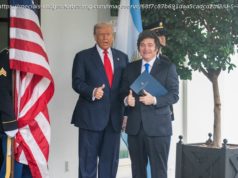
President-elect Donald Trump’s threat to impose a “major” border tax on U. S. manufacturers that make products abroad to sell in the U. S. could fuel the next leg in the post-election dollar rally, some analysts reckon.
In his first post-election press conference, Trump doubled down on his proposal to impose policies aimed at boosting onshore production of U. S. goods and services through penalties on imports. “There will be a major border tax on these companies that are leaving and getting away with murder,” Trump said on Wednesday, without elaborating. “You’ve got a lot of places you can move,” he added. “As long as it’s within the U. S.”
His pronouncement on Wednesday followed a Jan 3. tweet in which the Republican castigated General Motors Co. for its Mexico car plant, channeling the “make-where-we-sell” political movement.
General Motors is sending Mexican made model of Chevy Cruze to U. S. car dealers-tax free across border. Make in U. S. A.or pay big border tax!
The impact of any such border-tax policy, the implementation of which would likely require an act of Congress and may be prohibited (PDF) by World Trade Organization rules, could be significant for the greenback—and for emerging markets in particular.
Policy-driven efforts to boost America’s net trade position, either through an increase in tariffs or a border-adjustment tax, could trigger a fierce appreciation of the dollar, which would tighten financial conditions across the world.
Fiscal devaluation—an attempt to boost competitiveness through changes to the tax system—could upend projections for the dollar this year, which has staged a post-election advance amid expectations of higher interest rates and fiscal stimulus.
“We believe the FX market is too sanguine about the possibility of border adjustment being included in a final [fiscal] package,” Morgan Stanley strategists led by Todd Castagno wrote in a prescient report on Tuesday.
The dollar fell while demand for U. S. Treasuries rose in the wake of Trump’s tumultuous press conference. Nevertheless, the Bloomberg Dollar Spot Index, which tracks the currency against 10 of its peers, remains 4.9 percent higher since the election.
In simple terms, the border-tax policy is a destination-focused corporate tax that boosts exporters while disallowing deductions for imports, which would come as a blow to retailers and automakers in particular, given the high import component in their supply chains.
Traditional economic models suggest that exchange rates would fully adjust to changes in external competitiveness. In other words, the ensuing dollar strength would raise the cost of U. S. exports for foreigners and reduce import costs for U. S. business by a corresponding margin, offsetting the tax penalty on importers. That means that the net effect on the trade balance would be neutral.
However, given that currencies are rarely, if ever, at levels considered “fair value” in purchasing-power-parity terms, there’s no guarantee that this fiscal policy-induced shock to the terms of trade would be quickly, or fully, offset by changes in the foreign exchange market.
Morgan Stanley foresees a smaller rise in the dollar in the event of a 20 percent border-adjustment tax, rather than a one-time 25 percent appreciation of the dollar, as implied by textbook theory.
“We think a 10-15 percent rise in USD is reasonable,” Castagno and his team wrote. “Even if we don’t get a full exchange rate offset, the policy will still have a large impact on U. S. competitiveness and, therefore, the dollar.”
In other words, their projections suggest Trump may succeed in endowing exporters with a competitiveness boost since the dollar is unlikely to adjust fast enough to absorb the tax change. This view is echoed by Mark McCormick, of TD Securities Inc., who predicts the dollar may advance by 10 percent. “Exchange rates are unlikely to adjust rapidly enough in order to internalize the tax change,” the analyst wrote on Jan. 6. “In other words, a border adjustment tax is likely to boost the USD but the net change (USD strength and export subsidy) will likely still favor U. S. exporters and production.”
Market tremors from the tax would be felt around the world.
“In short, while the fiscal effects on the USD could be substantial by themselves, the implication from changed trade fundamentals could actually be a ‘yuuuge’ deal,” Martin Enlund, chief currency strategist at Nordea Markets, wrote in a note on Monday, nodding to a common expression favored by the U. S. president elect.
A further rise in the dollar’s trade-weighted value would add insult to injury for emerging markets, which are already grappling with the sharp rise in dollar-servicing costs in local-currency terms, tighter liquidity conditions, and pressure on currency pegs, he noted.
“Exchange rate adjustments are never as easy as theory would have it, and gray swans abound,” he adds, alluding to events that can be anticipated only to a certain degree. After all, exchange rates are driven by a slew of forces, including capital flows, interest rates, Federal Reserve policies, and global trade policies, while currency dynamics in U. S. protectionism are unique.
“Higher tariffs might have a similar impact: U. S. assets are likely to benefit from a flight to safety or flight to quality bid in the face of a global stagflationary shock,” Bank of America Corp. economists, led by Ethan Harris, concluded in a report in October.
Trump's Border Tax Threat May Weaponize the Dollar
Similarity rank: 1.






